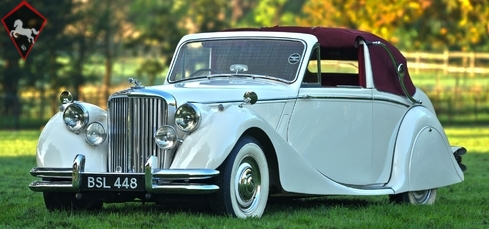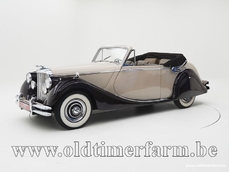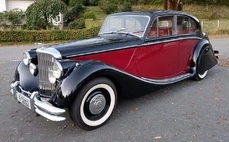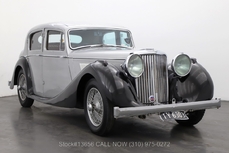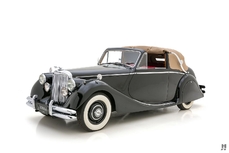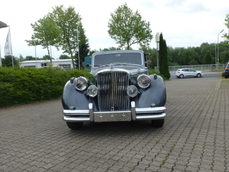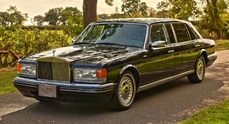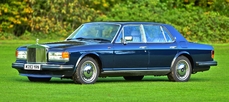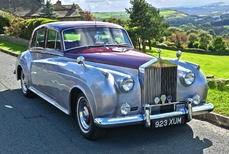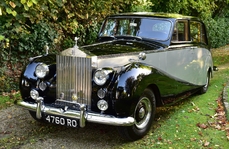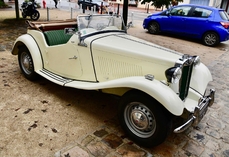Jaguar MkV 3.5 Litre 3-position DHC 1950
General description :
Vintage and Prestige are proud to offer this 1950 Jaguar MK V 3.5 Litre 3-position DHC For Sale.
Registration: BSL 448
Chassis no: 647242
Engine no: T 9633
The Jaguar MK V was launched at the 1948 London Motor Show at the same time as the XK120 with which it shared the stand. However, the Mark V vastly outsold the XK120 by roughly 5,000 cars per year as compared to 2,000 cars per year for the XK120.
The new large saloon did not get the new overhead camshaft XK engine however, instead keeping the overhead valve pushrod straight 6 units from the MK IV, except that for the Mk. V no 1.5 litre version was offered. Claimed power output in this application was 104bhp for the 2664cc Mark V and 126 bhp for its more popular 3486 cc sibling, as indeed this example presented is.
The chassis was new with independent front suspension by double wishbones and torsion bar, an arrangement that would be used by Jaguar for many future vehicles.
The styling of the car was traditional Jaguar with upright chrome grille complete with the leaping Jaguar radiator cap mascot available as an option. The wheels were 16-inch steel disc type, significantly smaller than the 18-inch ones on the Mk. IV. From the side, a distinctive styling touch was a ""tuck in"" curve at the base of the rear window following the curved profile of the side glass. Rear wheel spats were standard and there was also a drophead coupé version which is now highly sought after.
A 3.5 litre car tested by The Motor magazine in 1949 had a top speed of 90.7mph and could accelerate from 0-60 mph in 20.4 seconds. So competent were these cars that Jaguar's inimitable test engineer Norman Dewis used a Mk. V regularly.
This stunning example that we have the privilege of handling is not only presented with the more desirable 3.5 litre engine but the drophead configuration are becoming increasingly hard to find. BSL 448 was completely restored by Davenport cars in the late 90’s and finishing in the year 2000. The restoration is heavily documented and the end result was truly marvellous.
The MK V is still offered in beautiful condition today which is a testament to both the restorers and high level of car taken with BSL since this point.
Thanks to recent mechanical works she is driving and handling beautifully and is in our showroom ready for viewing.
http://www.vintagerollsroycecars.com/sales/1536/1950-jaguar-mk-v-3-5-litre-3-position-dhc/
1950 Jaguar MkV 3.5 Litre 3-position DHC is listed sold on ClassicDigest in Grays by Vintage Prestige for Not priced.
Car Facts
Car type : Car Make : Jaguar Model : MkV Model Version : 3.5 Litre 3-position DHC Engine size : 0.0 Model Year : 1950 Sub type : Convertible Location : Essex
Sold
Seller Information
Sold
People who viewed this Jaguar MkV also viewed similar Jaguar listed at ClassicDigest
Other cars listed for sale by this dealer
About Jaguar
Ah, the story of Jaguar, from its early days as the SS Cars Ltd. to its pinnacle with the D-type, and the street-going evolution in the form of the iconic E-type. There's something quintessentially British about this tale, and I'll narrate it as a British journalist might.In the Beginnings:
Our journey into the world of Jaguar begins in the 1930s, when a company known as SS Cars Ltd. emerged. Despite the unfortunate coincidence of their initials with the rising political tensions in Europe, they started producing stylish and performance-oriented cars. The SS 100, introduced in 1936, was a symbol of elegance and speed, setting the stage for what would become Jaguar.
The Birth of Jaguar:
As the shadows of World War II loomed, SS Cars Ltd. wisely decided to disassociate themselves from the SS initials. Thus, in 1945, they officially became Jaguar Cars Ltd., a name that would soon be synonymous with British luxury and performance.
The XK Series:
Jaguar's post-war era brought us the XK 120, a true sensation in 1948. With its sleek design and a powerful 3.4-liter inline-six engine, it became the world's fastest production car. The XK 120 was the blueprint for what lay ahead – Jaguars that blended style with speed in a uniquely British fashion.
The D-type Dominance:
Then came the D-type, a true racing legend. Introduced in 1954, it won Le Mans three times in the 1950s, showcasing Jaguar's engineering prowess. With its innovative monocoque construction and the iconic fin at the back, the D-type was the apex of Jaguar's motorsport success.
The E-type Emergence:
But the true turning point arrived in 1961 with the introduction of the E-type, often described by Enzo Ferrari as "the most beautiful car ever made." Its long bonnet, curvaceous body, and a 3.8-liter engine delivering exhilarating performance made it an instant classic. The E-type was not just a car; it was a work of art on wheels, and it could hit 150 mph on the road.
Street and Racing Success:
The E-type's beauty was matched by its capability on the track. The lightweight E-types were particularly successful in various racing events, cementing Jaguar's reputation as a force to be reckoned with in motorsport.
The Age of Refinement:
As we delve deeper into the Jaguar story, we find that the 1950s and 1960s were an age of refinement and expansion. Alongside the magnificent D-type and the E-type's iconic emergence, Jaguar introduced models that further solidified its reputation for luxury and performance.
The MK2:
In the late 1950s, Jaguar unveiled the MK2, a sports sedan that combined elegance with power. This sleek four-door saloon was a favorite of bank robbers and law enforcement alike, thanks to its exceptional speed and handling. The MK2 was a symbol of Jaguar's ability to blend sophistication with performance and had a successful racing career as well.
The XJ6:
Fast forward to 1968, and Jaguar launched a car that would define luxury saloons for decades to come – the XJ6. It was a masterpiece of engineering and design, featuring a smooth inline-six engine, independent rear suspension, and a spacious, beautifully appointed interior. The XJ6 was a symbol of British elegance and provided a ride so smooth that it seemed to glide over the road. It became the flagship model for Jaguar and set the standard for luxury saloons, showcasing a level of refinement that left competitors in awe.
The Blend of Classic and Modern:
While the MK2 and XJ6 represented the evolution of Jaguar's saloon cars, they maintained the brand's commitment to performance and luxury. These cars didn't just belong on the racetrack; they were equally at home cruising down the grand boulevards or gliding through the English countryside.
The Challenges of Change:
However, as the 1970s arrived, Jaguar, like many British automakers, faced financial challenges and changes in ownership. The British Leyland era brought both opportunities and struggles, as the brand navigated through various mergers and transitions.
Nevertheless, the legacy of the MK2 and XJ6, along with the D-type and E-type, continues to define Jaguar as a manufacturer that combines timeless elegance with a spirit of performance. These classic models, whether driven on winding roads or parked as collectors' treasures, serve as a testament to Jaguar's enduring presence in the world of automotive excellence.
The Jaguar story, from its early days as SS Cars Ltd. to the creation of automotive icons like the E-type, MK2, and XJ6, is a journey that reflects the very essence of British motoring – a blend of luxury, power, and style that continues to captivate enthusiasts and connoisseurs alike.
